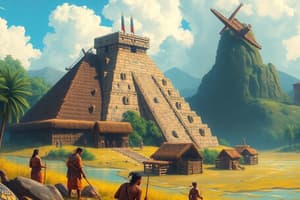Podcast
Questions and Answers
The Iroquois Confederacy was a monarchical system of government where the people had no say in the decision-making process.
The Iroquois Confederacy was a monarchical system of government where the people had no say in the decision-making process.
False (B)
Hiawatha was a Huron who persuaded the Onondaga man to promote peace and the Great Law of Peace.
Hiawatha was a Huron who persuaded the Onondaga man to promote peace and the Great Law of Peace.
False (B)
The Great Law of Peace was recorded on wampum belts made of precious stones.
The Great Law of Peace was recorded on wampum belts made of precious stones.
False (B)
The Iroquois Confederacy was composed of only four tribes: the Mohawk, Oneida, Onondaga, and Cayuga.
The Iroquois Confederacy was composed of only four tribes: the Mohawk, Oneida, Onondaga, and Cayuga.
Wampum was only used as a form of currency and was not used to store laws and records.
Wampum was only used as a form of currency and was not used to store laws and records.
The principles of the Iroquois Confederacy's government were based on war, inequality, and injustice.
The principles of the Iroquois Confederacy's government were based on war, inequality, and injustice.
The Iroquois Confederacy was a patriarchal society, meaning that descent was passed through the father rather than the mother.
The Iroquois Confederacy was a patriarchal society, meaning that descent was passed through the father rather than the mother.
The Clan Mother was responsible for governing the Iroquois Confederacy and making important decisions.
The Clan Mother was responsible for governing the Iroquois Confederacy and making important decisions.
Wampum was a key component of the Iroquois Confederacy's decision-making process.
Wampum was a key component of the Iroquois Confederacy's decision-making process.
Hiawatha was a leader of one of the Iroquois Nations.
Hiawatha was a leader of one of the Iroquois Nations.
The Iroquois Confederacy was a democratic society where all members had equal say in decision-making.
The Iroquois Confederacy was a democratic society where all members had equal say in decision-making.
The Iroquois Confederacy was organized into clans, which were the basic unit of social organization.
The Iroquois Confederacy was organized into clans, which were the basic unit of social organization.
Flashcards are hidden until you start studying
Study Notes
Iroquois Confederacy: Democracy, Hiawatha, Wampum, and Clans
The Iroquois Confederacy, also known as the Haudenosaunee Confederacy, was one of the most influential indigenous political entities in North America. The confederacy was formed around 1570 and lasted until the late 18th century. It played a significant role in the struggle between the French and British for control of the northeastern region of North America. The tribes that made up the confederacy were the Mohawk, Oneida, Onondaga, Cayuga, and Seneca, with the Tuscarora later joining in 1722.
Democracy
The Iroquois Confederacy is considered one of the world's oldest participatory democracies. The Great Law of Peace, or Gayanesshagowa, established a representative form of government where the people in the clans had a say in what information was passed upward. This unique form of government is based on the principles of peace, equity, and justice.
Hiawatha
The formation of the confederacy is attributed to Dekanawidah, also known as the Peacemaker, who was a Huron. He persuaded an Onondaga man named Hiawatha to promote peace, civil authority, righteousness, and the Great Law of Peace as sanctions for confederation.
Wampum
The Great Law of Peace was recorded on wampum belts, which are made of shells. These belts were used to store laws and records. Wampum was also used as a form of currency and was traded between tribes for goods and services.
Clans
The Iroquois Confederacy was organized around clans, which were the basic unit of social organization. Members of one clan were considered relatives, and intermarriage within the same clan was forbidden. Each clan was led by a Clan Mother, who was responsible for naming all those in the clan and selecting the male candidate for Chief, who the rest of the Clan must approve. The Clan Mother could also remove a Chief if he failed in his duties.
The Iroquois Confederacy was a matrilineal society, meaning that descent was passed through the mother rather than the father. Both men and women had equal roles in the social, political, and economic life of the community.
The Iroquois Nations were organized similar to a large longhouse, with each nation representing a family. The Mohawk were the keepers of the eastern door, the Seneca of the western door, and the Onondagas of the central fire. The Cayuga, Oneida, and Tuscarora were the younger brothers, representing the other families that completed the longhouse.
Today, some longhouses still exist on Haudenosaunee reservations and are used for ceremonial purposes.
Studying That Suits You
Use AI to generate personalized quizzes and flashcards to suit your learning preferences.




